La Peschiera in Santa Fiora
a 14th century fishery that your kids won't want to leave
From the outside, La Peschiera in Santa Fiora doesn't look like the kind of place that would bring huge smiles to the faces of 21st century children, let alone have them letting out squeals of joy and keep them amused for a couple of hours. After all it is a 14th century fishery. But it will. And the thing is that it is in a setting that you will love too.
They get to feed ginormous fish with huge mouths and big lips! Learn that it once kept the tables of the middle ages nobility who lived up on the hill laden with fresh fish. And now is the home of a preservation project underway to repopulate the rivers of Maremma and Tuscany with trout.
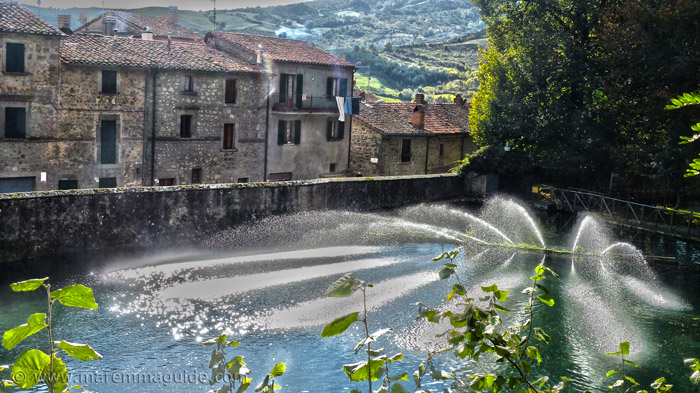
You get to feed those huge fish too - if your kids are willing to share the fish food with you - because it is fun!
TIP Take a pocket of one Euro coins with you!
See their delighted faces and hear their squeals when the trout - especially the smaller, younger ones - all jump out of the water in their frenzy to eat the fish pellets, splashing onlookers as they do. Which means mum gets wet if she isn't forewarned!
A lovely view of Santa Fiora that is well worthy of some photographs. And a walk around large, well-kept gardens with plenty of picnic spots. There is a herb corner too which just begs for you to rub a leaf or two to release their perfume.
And be introduced to Romeo and his Juliet. Actually, they will introduce themselves.
All for free. Well, nearly. Entrance for adults costs one Euro. Children can stay as long as they like for free. Then it is just how many "balls" - the fish pellets come in see-through plastic balls from a dispenser inside - you are willing to allow your kids to buy. They cost one Euro.
I forget how many times I say, "stop, no more", but give in for the sheer pleasure of the experience for me too.
TIP for KIDS: When mum finally says no more and doesn't change her mind, look in the crevices and holes along the top of the pond wall; you might be lucky to find some :)
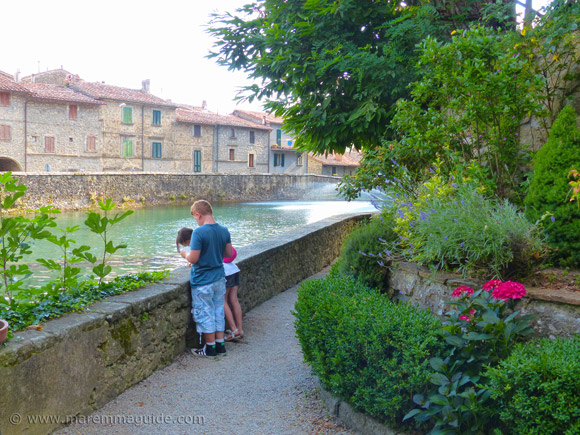
But that's not all
But that's not all. There is something else at the Peschiera. Actually, three something else's.
Which at first, second, and even third glances, if you happen to go up into the garden above the primary pond and look down, you will mistake for a bed of algae. Until that is, they move. But only ever so slightly. So as to make you doubt your own eyes. And then again, until you can reach no other conclusion that they are fish. Enormous fish! And they are.
The fish in the ponds
You'll get to see "Trota Fario" - Brook Trout (Salmo trutta fario), "Trota Iridea" - Rainbow Trout (Oncorhynchus mykiss), and "Carpa" - Common Carp (Cyprinus carpio).
These are the Brook Trout.
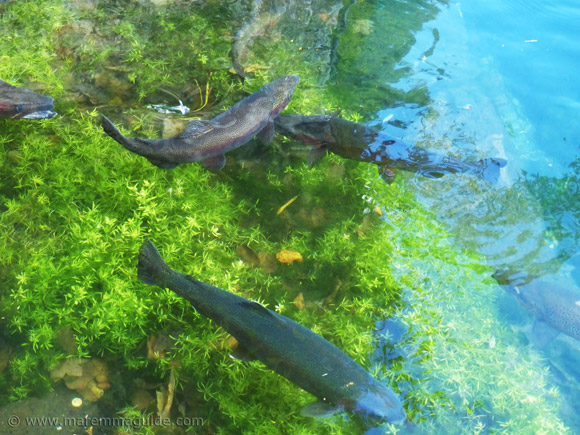
But those enormous ones are special. For they are European sea sturgeon - "Storione" - a critically endangered species. Two of the larger of the three weigh in at no less than around 33 kilos each! And these three haven't even reached their full potential length or weight!
European sea sturgeon have been known to live for 100 years, reach six metres in length, and weigh 400 kilos!
They rarely come close to the wall of the pond where the visitors are, and don't seem at all interested in the pellet food when they do. At their size, if I was Romeo or Juliet with my "feet" near permanently submerged in this pond I would fear for my toes! But I guess they already know that these three are bottom-feeders, only eating crustaceans and mollusks, rather than ducks!
Spot the sturgeon from afar.
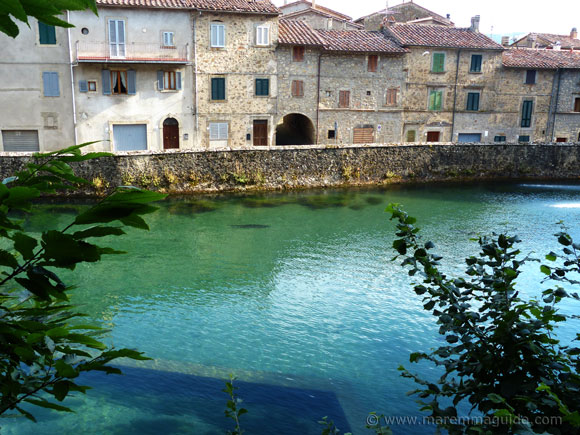
With a zoom: now there are two. To give you a perspective on size, that fish on the left above the upper sturgeon is one of those big Brook trout.
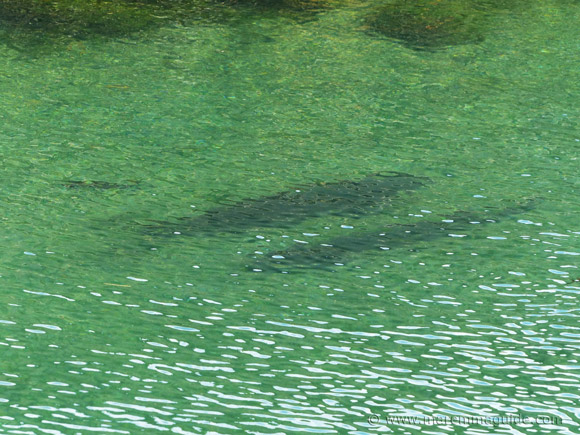
See them in the video.
The video
An admission: during the filming of this video we did something that we shouldn't have. We didn't realise at the time that it was prohibited, not until we went back to the fish pellet dispenser to buy some more and read an information sign nearby. We gave the fish a couple of pieces of cheese from our panino! Please note that they may only be fed pellets, and not "pecorino stagionato" (mature Tuscan cheese), however much it tastes good and they seemed to love it!
Romeo and Juliet
That's Romeo and his Juliet on their way to us in the hope of eating some of those pellets too, but they usually loose out big time to the fish. They are a resident "married" couple of geese.
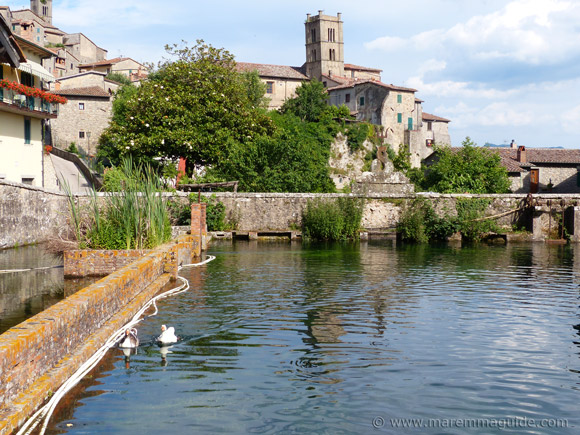
The park
The la Peschiera in Santa Fiora sits within a large park, enclosed by a high trachite wall. It is a lovely spot to take a shady break during the heat of summer, to lay out a picnic, or simply to give your children some free play time and safe space to run around in and explore.
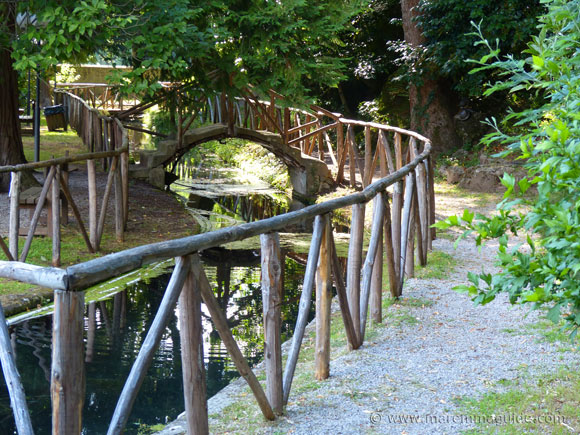
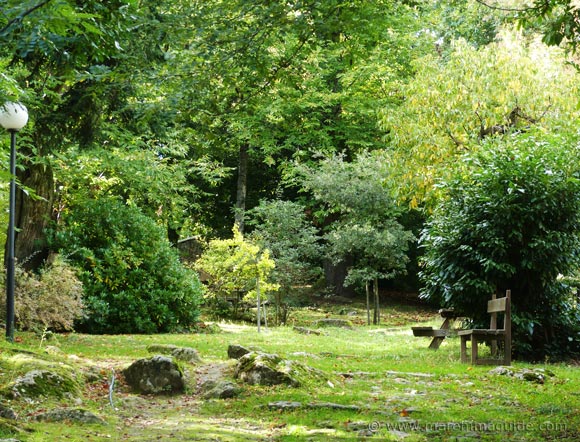
They'll get to spot three kings.
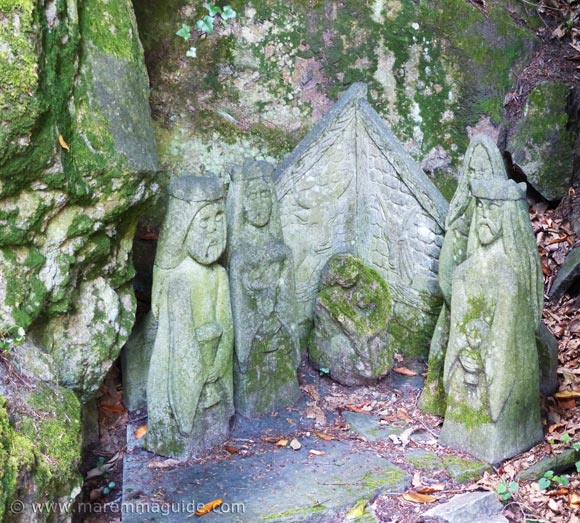
And fungi too.
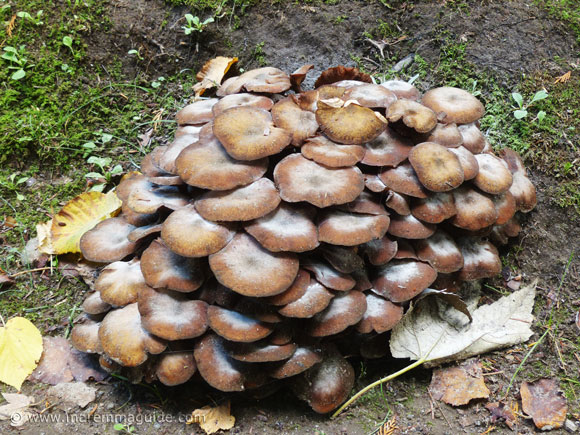
A little bit of a lot of history
Although there is scant information from the period, there is little doubt that the Peschiera was well established in the fourteenth century as the trout fishery of the Maremma nobility ruling Santa Fiora and its territories at the time, the Aldobrandeschi family.
The earliest surviving record is that of text written by Pope Pio II in 1464, when he was staying in Santa Fiora as a guest of Count Guido Sforza.
The marriage of the last heir of the Aldobrandeschi family, Cecelia Aldobrandeschi to Bosio I Sforza in 1439, turned Santa Fiora over to the Sforza family and began a new branch of Sforza Counts: the Sforza di Santa Fiora. Count Guido Sforza, with whom Pope Pio II was their second child.
The Peschiera was restored for the first time around the year 1575, when the imposing Palazzo Sforza with its towers was built in the centre of Santa Fiora on the site of the original "rocca" fortification of the Aldobrandeschi family.
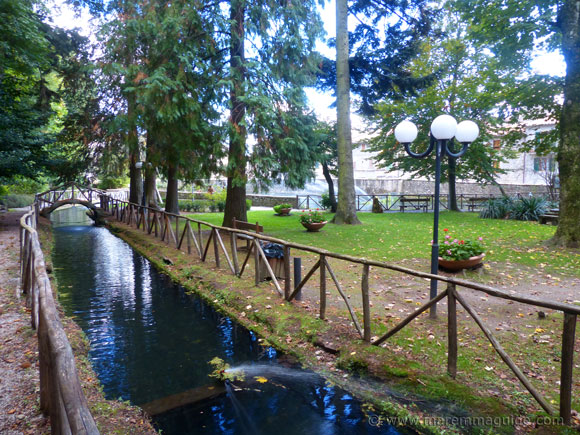
By the eighteenth century, however, it was in a state of disrepair and leaking water.
A 1750 design exists showing in great detail the two containing Sienese walls, the "lavatoio" (wash house area) and no less than twenty-two wrought-iron channels that controlled the ebb and flow of the spring under the church floor, jetting water into the "lavatoio".
From rack and ruin to an English garden
In 1851, the Peschiera was restored again, this time by Duke Lorenzo Sforza Cesarini. He had the whole complex and its surrounding park enclosed in secure and even higher walls. A Renaissance garden was created in which the English Duchess Carolina Shirley Sforza Cesarini had magnolias, rhododendrons, violets, fragrant freesias, lily of the valley and roses after roses planted amongst the cypress, lime, Lebanon cedar, pine, Holm oaks, firs and ancient chestnut trees. All with a view of a calm lake. It was described in texts of the day as a delightful English park.
You'll find the park layout today, just as it was then, over a hundred and sixty years ago when the Sforza couple walked through it.
If you ever get the chance, or the inclination to do so, the life stories of the Duke and Duchess are fascinating. Both were born illegitimately - Caroline's mother was a servant girl - both were heirs to fortunes, and married each other four times to secure them! The things I find out when writing about a garden!
Getting to La Peschiera in Santa Fiora
Once you arrive in the centre of Santa Fiora the Peschiera is well sign-posted, but that isn't to mean that you won't doubt that you are driving in the right direction when you follow the signs!
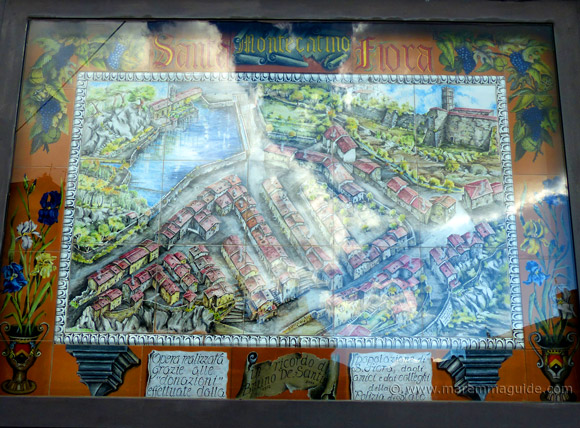 La Peschiera is located in Santa Fiora's Terziere di Montecatino.
La Peschiera is located in Santa Fiora's Terziere di Montecatino.For when you leave the central roundabout along Via Aldo Moro and head down Strada Provinciale la Bella, you will reach a point where the road you need to take to the right doesn't look like one that you should in the sense that it is a tight turn and very narrow, much too narrow for the two-way traffic that passes along it. Even if there is a "Via della Peschiera" sign on the house wall in front of you. The left turn option at this point is into the historic centre of the town through an entrance in the city walls. And that doesn't look like the place to go either!
I was lucky that on my first visit to Santa Fiora I had an Italian girlfriend and her children with me and she knows the town very well - the fishery belonged to her family a few generations ago - and she reassured me we were OK to continue.
So, turn right! The road widens a little as you go down the hillside and you will pass the entrance to the fishery on your right.
Parking
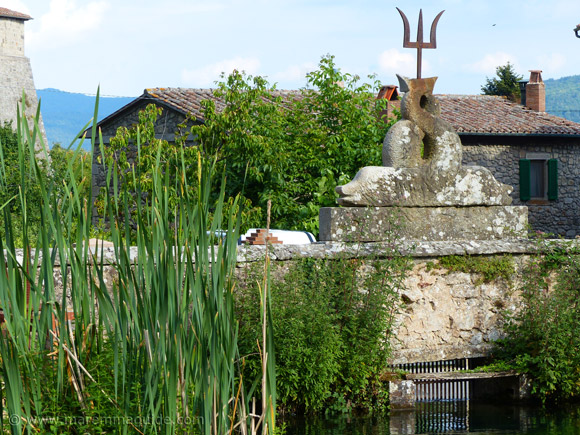
Drive past the church and the two dolphins with the trident (the pagan symbol for water). Turn right and, if you are lucky, you will be able to find a parking space in the Terziere di Montecatini, alongside the external wall of the fishery. From there it is just a few feet walk back to the entrance.
Opening times
From 1 April to 31 May: 09:00 to 20:00.
From 1 to 30 June: 09:00 to 22:00.
From 1 July to 31 August: 09:00 to 24:00.
From 1 to 30 September: 09:00 to 22:00.
And, from 1 October to 31 March: 09:00 to 16:00.
The information telephone number is a mobile one : +39 339 2104807.
Live music, dinner and dancing in the park
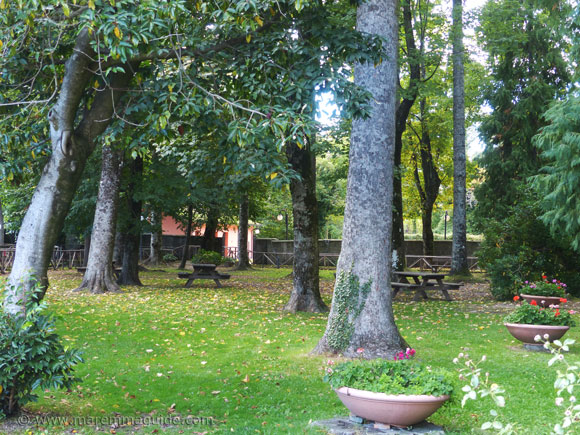
During the summer, the area in front of the pink building in the park turns into an outdoor restaurant with live music. Both the lunch and dinner menus are of the day and consist of local dishes and pizza made from organic, zero kilometre, produce.
To book tel. +39 327 6184168.
Watch La Peschiera in Santa Fiora live :)
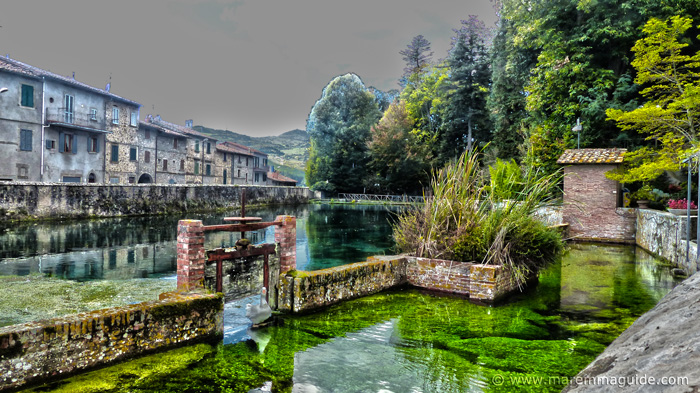
You can take a look at la Peschiera in Santa Fiora right now, in snips of two seconds, on the Minierio di Mercurio - the Mercury Mine - in Santa Fiora web-cam. You even get to see Romeo and the ripples he makes on the pond!
The surprise next door
Walk out of the entrance to the fishery, along the road that was once the site of nothing less than miracles, and you will find a tiny Maremma church with a glass floor. It is called the Chiesa della Madonna delle Nevi - the Church of Our Lady of the Snows.
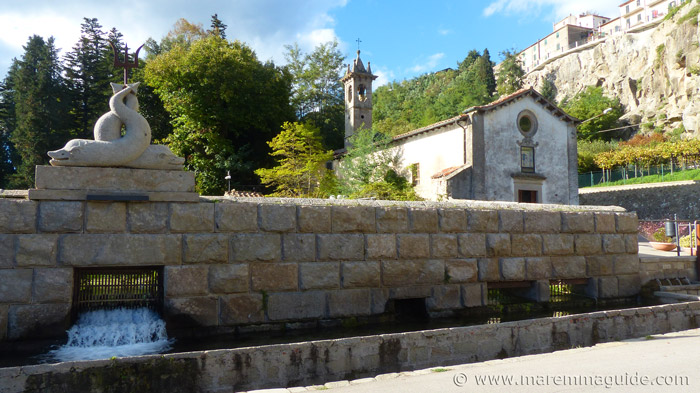 The long channel of water fed by the Peschiera waters that flow through the metal grill below the dolphins was once used for watering animals and as Santa Fiora's outdoor wash house. It is still sometimes used by local women today.
The long channel of water fed by the Peschiera waters that flow through the metal grill below the dolphins was once used for watering animals and as Santa Fiora's outdoor wash house. It is still sometimes used by local women today.In fact, chances are you saw it before the Peschiera and, if you have children with you and you can, it is best explored before the fishery as a look inside will have them even more excited to do so.
Explore Santa Fiora
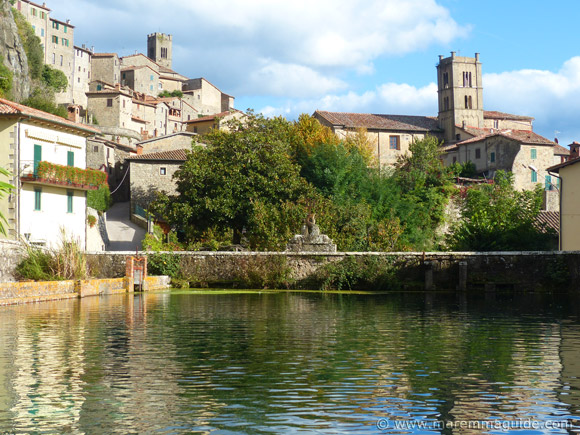
The best way to explore Santa Fiora from la Peschiera isn't to take the road you drove down, but to walk instead up the narrow road that you can see to the left in this photograph. It will take you into Terziere di Borgo territory - a must see, either on your way up, or way down, or both times as I did. It has a fascinating history and is the site of Santa Fiora's ancient Jewish ghetto.
Explore some more...
















